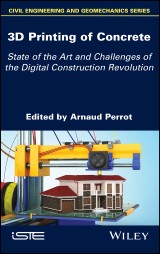Details
3D Printing of Concrete
State of the Art and Challenges of the Digital Construction Revolution1. Aufl.
|
139,99 € |
|
| Verlag: | Wiley |
| Format: | EPUB |
| Veröffentl.: | 10.04.2019 |
| ISBN/EAN: | 9781119610786 |
| Sprache: | englisch |
| Anzahl Seiten: | 176 |
DRM-geschütztes eBook, Sie benötigen z.B. Adobe Digital Editions und eine Adobe ID zum Lesen.
Beschreibungen
<p>The introduction of digital manufacturing techniques, such as 3D printing applied to concrete material, opens up new perspectives on the way in which buildings are designed. Research on this theme is thriving and there is a high rate of innovation related to concrete. At the same time, the first life-size constructions made from printed concrete are emerging from the ground.<br /> <br /> This book presents state-of-the-art knowledge on the different printing processes as well as on the concrete material that must adapt to these new manufacturing techniques, such as new hardware and new printers for concrete. The possibilities in terms of architectural design are discussed as well as the pathways that remain to be uncovered. The book also explores the challenges that researchers and companies expect to overcome as they get closer to democratizing this potential revolution that is the digital manufacturing of concrete. </p>
<p>Introduction ix<br /><i>Arnaud PERROT</i></p> <p><b>Chapter 1. 3D Printing in Concrete: General Considerations and Technologies 1<br /></b><i>Arnaud PERROT and Sofiane AMZIANE</i></p> <p>1.1. Introduction 1</p> <p>1.2. General considerations for 3D printing and additive fabrication 2</p> <p>1.2.1. What is 3D printing? 2</p> <p>1.2.2. Towards the 3D printing of cement-based materials 7</p> <p>1.3. The digital and additive fabrication of cement materials 7</p> <p>1.3.1. Introduction 7</p> <p>1.3.2. Printed methods using extrusion and deposition 9</p> <p>1.3.3. Methods of printing by injection into a particle bed 22</p> <p>1.3.4. Alternative printing methods 25</p> <p>1.4. A classification of 3D printing methods for concrete 29</p> <p>1.4.1. Philosophy 29</p> <p>1.4.2. Classification parameters 30</p> <p>1.4.3. Example of classification 33</p> <p>1.5. References 35</p> <p><b>Chapter 2. 3D Printing in Concrete: Techniques for Extrusion/Casting </b><b>41<br /></b><i>Arnaud PERROT and Damien RANGEARD</i></p> <p>2.1. Introduction 41</p> <p>2.2. Breakdown of the process into stages 43</p> <p>2.3. Behavior during the fresh state and the printing stage 46</p> <p>2.3.1. Rheology of cement-based materials 46</p> <p>2.3.2. Pumping 52</p> <p>2.3.3. Extrusion 54</p> <p>2.3.4. Stability of an elemental layer during deposition 56</p> <p>2.3.5. Overall stability of the printed structure in a wet state 58</p> <p>2.4. Other problems occurring during concrete extrusion printing 62</p> <p>2.4.1. Elastic deformation and accuracy of the deposition 62</p> <p>2.4.2. Shrinkage and cracking during drying 63</p> <p>2.4.3. Bonding between layers – weakness at the interface between layers 65</p> <p>2.4.4. Concept of time windows 66</p> <p>2.5. Conclusion 67</p> <p>2.6. References 68</p> <p><b>Chapter 3. 3D Printing by Selective Binding in a Particle Bed: Principles and Challenges </b><b>73<br /></b><i>Alexandre PIERRE and Arnaud PERROT</i></p> <p>3.1. Introduction 73</p> <p>3.2. Classification of selective printing processes and strategies 75</p> <p>3.2.1. Selective cement activation 77</p> <p>3.2.2. Selective paste intrusion 80</p> <p>3.2.3. Injection of the binder 82</p> <p>3.3. State of the art of selective printing and major achievements 82</p> <p>3.4. Scientific challenges 84</p> <p>3.4.1. Selective cement activation and the effect of water penetration 84</p> <p>3.4.2. Selective intrusion and penetration by cement paste 89</p> <p>3.4.3. Towards modeling in 3D 94</p> <p>3.5. Conclusion 96</p> <p>3.6. References 96</p> <p><b>Chapter 4. Mechanical Behavior of 3D Printed Cement Materials </b><b>101<br /></b><i>Mohammed SONEBI, Sofiane AMZIANE and Arnaud PERROT</i></p> <p>4.1. Introduction 101</p> <p>4.2. Mechanical performance of the cement materials printed using the extrusion/deposition method 102</p> <p>4.2.1. Effect of extrusion on the mechanical characteristics of cement-based composites 103</p> <p>4.2.2. Mechanical behavior of 3D printed cement materials 105</p> <p>4.3 Effects of the additive fabrication method on the mechanical behavior of cement-based materials 116</p> <p>4.3.1. Printed concrete = anisotropic stratified materials: possible causes 116</p> <p>4.3.2. Effects of the printing process parameters on the mechanical properties 116</p> <p>4.4. Mechanical behavior obtained with other methods of 3D printing of cement-based materials 119</p> <p>4.4.1. Production using robotic sliding castings (“Smart Dynamic Casting”) 119</p> <p>4.4.2. Printing using the method of injection into a particle bed 119</p> <p>4.5. Conclusion 120</p> <p>4.6. References 121</p> <p><b>Chapter 5. 3D Printing with Concrete: Impact and Designs of Structures </b><b>125<br /></b><i>Arnaud PERROT and Damien RANGEARD</i></p> <p>5.1. Introduction 125</p> <p>5.2. Freedom of forms: architectural liberation and topological optimization 126</p> <p>5.2.1. 3D printing with concrete: a boon for architects? 126</p> <p>5.2.2. Towards the creation of structures with optimized shapes? 128</p> <p>5.2.3. Could 3D concrete printers go through a transition similar to the transition from black and white to color? 130</p> <p>5.3. Design of structures: reinforcement strategies and design codes 131</p> <p>5.3.1. The use of fibers 132</p> <p>5.3.2. External reinforcements 133</p> <p>5.3.3. Steel wire placed within the extruded material 133</p> <p>5.3.4. Dedicated spaces acting as lost formworks 134</p> <p>5.3.5. Wrapping of reinforcement elements set in place beforehand 135</p> <p>5.3.6. Towards a specific design code? 136</p> <p>5.4. Impacts of 3D printing 136</p> <p>5.4.1. Environmental impact 136</p> <p>5.4.2. Societal impact 138</p> <p>5.4.3. Economic impact 139</p> <p>5.5. Conclusion 140</p> <p>5.6. References 141</p> <p>List of Authors 145</p> <p>Index 147</p>
<p><b>Arnaud Perrot</b> has been Research Professor at Université Bretagne Sud, France, since 2007. He is the author of over 50 scientific articles in the field of the implementation and rheology of cement-based materials.</p>



















